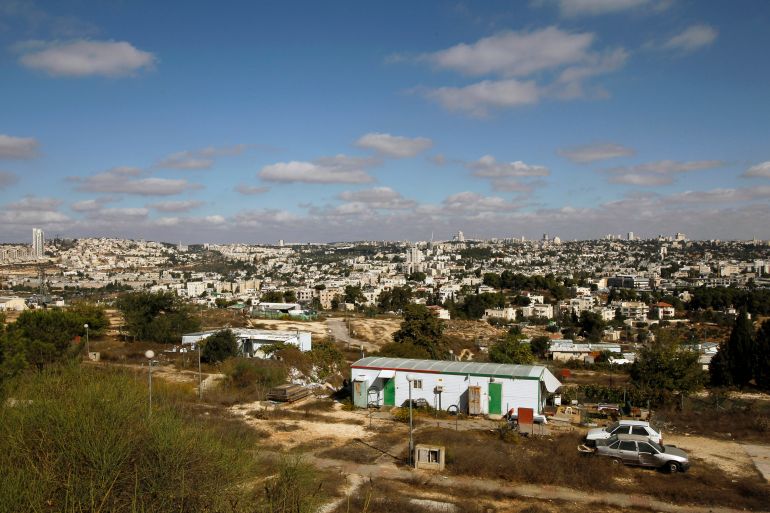Israel approves building plan in illegal Jerusalem settlement
The plan would cut off the neighbourhood of Beit Safafa from Palestinian villages while linking Israeli settlements.

Occupied East Jerusalem – Israeli occupation authorities in Jerusalem have approved a plan to build housing units in an illegal settlement on the Palestinian area of Khirbet Tabalya, southwest of the city.
On Wednesday, the Israeli-controlled Jerusalem municipality’s local planning committee approved the plan to construct “public buildings and roads” in the illegal Jewish settlement of “Giv’at Hamatos”, according to Israeli media.
Keep reading
list of 4 itemsWill it be safe for Palestinians in Gaza to return and rebuild their homes?
Palestinian President Abbas says only US can halt Israel’s attack on Rafah
Protesters heckle White House correspondents’ dinner guests
At present, the illegal settlement consists of a set of caravans and mobile homes set up in the early 1990s for Ethiopian settlers.
According to Jerusalem map expert Khalil Toufakji, the area spans some 900 dunams.
“This is old-new. [Israel] is transforming the lands that were confiscated […] into long-term buildings,” Toufakji told Al Jazeera.
If built, it would be “the first new settlement created in East Jerusalem in the last 20 years.”
Toufakji explained that part of the lands belonged to the German Lutheran Church, while other parts were classified as private Palestinian property, including for refugees, and pointed to previous sales of lands owned by the church for Jewish settlements north of Nazareth – in the “Bethlehem of the Galilee” – and Sarona, near Tel Aviv.
The announcement came a day after Israeli Foreign Minister Yair Lapid met United States Vice President Kamala Harris in Washington, DC.
Plans since 2012 to build units in the settlement were previously met with strong opposition from Israeli allies Germany and the US, causing authorities to repeatedly postpone implementation.
But in April 2020, authorities announced that 6,500 housing units would be built for the settlement, supplanting previous plans for the area which included construction of 3,400 housing units and 1,100 hotel rooms.
In November 2020, Israel issued a tender for the construction of 1,257 units in the settlement.
Toufakji said he believes it is likely that during the last visit of Germany’s outgoing chancellor Angela Merkel to Jerusalem earlier this week, “she gave them [Israeli authorities] the green light to continue with the settlement – or at least lifted the cloak of German pressure.”
The Biden administration has not yet commented on the new development.
The settlement lies on lands across the 1967 Green Line, seized from the Palestinian towns of Beit Safafa in the Jerusalem governate, and Beit Jala in the Bethlehem governate.
The construction plan would cut off Beit Safafa from the surrounding Palestinian villages and from the rest of Jerusalem. It would also link together the nearby Israeli settlements of Jabal Abu Ghneim, or “Har Homa,” with “Gilo”, and the proposed “Giv’at Yael” settlement on lands belonging to the Palestinian town of Walajeh.
Fayrouz Sharqawi, of Grassroots Al-Quds (Jerusalem), told Al Jazeera the case of Khirbet Tabalya is part of the Israeli occupation’s “overall colonial planning policies in Jerusalem”.
She said the aim is to “sever Palestinian communities and suffocate them, prevent their growth” to use as “a tool of displacement,” adding that the settlement would mean “severance of all Palestinian links to Beit Safafa, isolating it entirely”.
According to Toufakji, building the “Giv’at Hamatos” settlement is part of the 2020 ‘Greater Jerusalem’ master plan, originally drawn up in 2004.
One of the main goals outlined in the master plan is to “maintain a solid Jewish majority in the city” and entrench Israeli domination by connecting settlements in the West Bank to Jerusalem and Tel Aviv.
Israel is advancing the expansion of several other settlements in occupied Jerusalem and the West Bank.
According to Israeli media, the planning committee on Wednesday also approved filing plans for expanding one of the largest settlements in Jerusalem, “Pisgat Ze’ev” built on Palestinian land in the neighborhoods of Beit Hanina, Shuafat and Hizma.
Next week, authorities will also discuss building a new settlement that would split the occupied West Bank in half, known as the E1 plan, with the aim of linking the settlement bloc of Maaleh Adumim to Jerusalem.
The E1 plan also places dozens of Palestinian Bedouin communities in the area at risk of forced displacement.
Additionally, Israeli authorities have begun promoting the construction of more than 9,000 units for a new settlement named “Atarot” on land belonging to the Palestinian village of Qalandia, in northern occupied Jerusalem.
The settlement, along with the existing military checkpoint in the area, would further separate the cities of Ramallah and Jerusalem from one another.